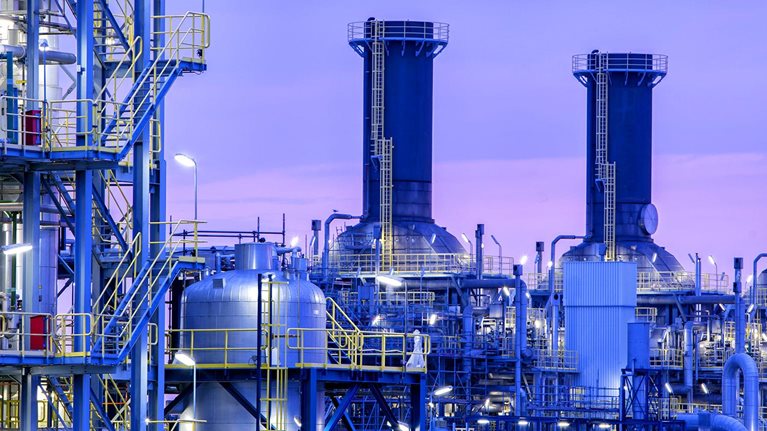The global petrochemical industry has enjoyed prolonged growth in recent years. Indeed, the petrochemical value pool has increased by a compound growth rate of 8 percent per year since 2010. Tapping into advantaged feedstock in the Middle East and United States has been one of the major contributors to this growth. The industry also has benefited from overall high-profit margins underpinned by robust demand from packaging and consumer-goods companies and supply disruptions resulting from the COVID-19 pandemic, albeit with regional differences.
In the coming years, however, significant capacity additions and slowing demand growth may result in a shrinking industry value pool. We have recently observed the first signs of a slowdown, with declining integrated margins of petrochemical products.
To address the challenges of an uncertain and volatile market, petrochemical companies should double down on performance excellence. A company can capture its full potential by achieving excellence across all functions, including operations, maintenance, supply chain, procurement, and talent management. Nothing less than a broad-based transformation can enable companies to outperform their competitors and capture new value pools. In this article, we review the sector’s performance, explore the trends that will influence the industry, and outline the principles of a full-potential transformation.
The medium-term market outlook
Three factors contributed to the petrochemical industry’s performance in the past decade. First, margins improved because of tight markets across all regions; for example, ethylene utilization rates improved by 4 percent between 2012 and 2018. Second, ethylene capacity continued to grow by 30 million tons a year (MTA), partly fueled by advantaged feedstock, especially in the Middle East and North America. Third, there was strong demand growth in emerging markets, contributing more than 40 percent of the growth in the value pool from 2010 to 2018.
In 2019, significant capacity additions and slowing demand growth caused the industry value pool to shrink. The pandemic further accelerated this decline in 2020. The pandemic’s impact on petrochemical demand was uneven, with automotive and construction applications experiencing steep drops while packaging demand (especially in food, sanitary products, medical applications, and online shopping) remained robust. Reasons for the latter include stockpiling, a surge in delivery services, and increased healthcare-focused activity.
However, most of these trends were transitory. When much of the world started to exit from COVID-19 lockdowns, the combination of pent-up demand across all sectors and problems with supply chains globally contributed to record margins in 2021 and early 2022. But with the recent economic slowdown and new capacity coming online around the world, margins are weakening again.
Several trends are expected to affect demand for petrochemicals. Continued growth of the critical end markets that consume petrochemicals—such as packaging and construction—and economic development in China, India, and Southeast Asia will have a positive effect on demand. Plastics recycling is also an important driver for the industry because the material flow from advanced recycling involves cracker and polymerization units.
Overall, we expect that these factors will result in a petrochemical growth rate of about 3 percent per year in the next decade, lower than earlier estimates. But petrochemicals remains the fastest-growing segment in the hydrocarbon value chain and will continue to offer high growth and relatively high margins for integrated-energy companies.
On the supply side, petrochemical capacity is expected to continue to grow at healthy rates over the next five years (Exhibit 1). While the pandemic has led to a slowdown in some capital projects, we expect to see strong growth in the coming years. About 42 MTA of ethylene capacity is expected to be added from 2022 to 2026 (including potential new projects), with China contributing about 19 MTA of confirmed capacity (or 58 percent of the global total), followed by North America at about five MTA (or 15 percent of the global total).

The expected capacity additions will lead to an increasing mismatch between supply and demand, given that the forecast capacity growth exceeds demand growth of 3 percent per year. The imbalance could further affect utilization and ultimately product profit margins. Ethylene operating rates in the coming years are expected to fall when the new capacity comes onstream. A drop in utilization could lead to lower margins, based on the historical correlation between margin and global operating rate.
In the longer term, ethylene utilization rates and product margins are expected to improve in the second half of this decade. Industry conduct and investment behavior will govern the extent of improvement. However, the state of the industry now and in the short term is not as bright, emphasizing the value of performance excellence for the longer term.
Principles of a successful full-potential transformation
Petrochemical companies are well positioned to pursue a full-potential transformation. We have observed that the most difficult part of transforming performance isn’t determining what to do but figuring out how to do it. Successful transformations depend on a performance infrastructure made up of talented people, streamlined processes, and sustainable results, with outcomes linked to direct financial impact.
For companies in financial distress, transformations tend to focus on immediate and radical cost reduction. But many companies, including major petrochemical companies, operate in relatively healthy and stable product categories. For these organizations, transformation isn’t a fight for survival; instead, it tends to be about reaching the full potential of the business (going from good to great) or responding to an external challenge or opportunity, such as learning how to win in new channels or shifting away from a historical moneymaker.
Our experience suggests that, regardless of the circumstances, real transformation happens only when a leadership team embraces the idea of holistic change in how the business operates—tackling all the factors that create value for an organization, including top line, bottom line, capital expenditures, and working capital. For instance, one large North American polymer company significantly increased production in its flagship facility but failed to push beyond throughput and yield improvements. This was a positive step, but it left significant opportunities in other parts of the business, such as cost and maintenance efficiency, on the table.
The performance infrastructure consists of the people, process, and tools that work in concert to ensure superior execution and value delivery. It serves as the central nervous system for a transformation effort and plays a vital role in the effort’s success.
People. To oversee the execution of each workstream (or area of activity), ensure decisions are made quickly, and keep the transformation on course, companies must create a governance structure—specifically, a transformation office comprising a few respected executives supported by analysts from the finance functions.
Process. The cadence of weekly transformation meetings is an indispensable part of creating an effective performance infrastructure. This cadence is aggressive and relentless, and it works. It helps enforce closed-loop accountability and accelerates implementation by preventing “pocket vetoes,” other delaying tactics, and slippage.
Tools. The third component of the performance infrastructure is the tools and systems used to monitor performance. These might include organizational-health assessments, benchmarks, value-capture models, and visual management and planning aids. For instance, advanced initiative-tracking tools that can be sorted by owner, department, delivery status, and other criteria allow users to understand, at a glance, the progress of all initiatives. The tools should make it easy to spot delays, observe trends, monitor impact, and create rich yet user-friendly reports. And these tools should be available to everyone involved in the transformation.
Best practices and opportunities to improve value
Capturing value across all the workstreams of the transformation framework requires employing best practices coupled with top-down (financial) and bottom-up (functional) benchmarks. Benchmarks help organizations identify where to start and how to prioritize, but real insights will emerge through more intense interactions within the organization—such as analysis of data sets, idea-generation workshops, and discussions with internal subject-matter experts. A focused effort to unearth ideas from the results can lead to solid initiatives and a bankable plan that creates tangible impact. Let’s look at the functions in petrochemical companies that can derive the most value from a transformation.
Operations
Companies can maximize revenue with little to no additional capital spending. Operations improvement focuses on yield, energy, throughput, and quality without affecting safety and reliability. Companies can pursue a combination of top-down benchmarking of individual unit performance and bottom-up idea generation, translating identified performance gaps into specific improvement opportunities. When process engineers and operators are motivated to suggest initiatives to improve performance of their plants, they often have ideas that focus on yield and throughput improvement with limited capital spending. An overarching theme of all transformations across industries is the increased use of digital tools and data and analytics to improve operations. Petrochemical organizations have also benefited from the adoption of data and analytics to improve yield, quality, throughput, and reliability (see sidebar, “Operational improvement levers for the para-xylene separation step”).
In one example involving implementation of advanced analytics, a specialty polymer manufacturer was able to nearly double the output of an in-demand production line. Advanced analytics revealed insights that process engineers had missed, sparking small hardware and control-loop changes that doubled the facility’s uptime. Other examples of impact from advanced analytics include detailed analytics on changeover time; the overhauling of product-wheel scheduling tools to incorporate broader data sets on cost, margins, and inventory positions; dynamic bottleneck advisory tools; and online inferential quality predictions.
Maintenance, reliability, and turnaround
Maintenance is about ensuring reliability at the lowest cost. Efficiency is an important factor in cost-effective maintenance, and upgrading that efficiency reduces cost and improves reliability. Typically, more than half of routine maintenance cost goes to labor. We frequently see waste and inefficiencies in maintenance tasks, such as two people working when only one is needed, workers spending time finding parts, or technicians waiting for machines to become available. For this reason, wrench-time assessment and its improvement are fundamental levers in optimizing maintenance costs. Whether maintenance is outsourced or done in-house, inefficiency has a cost.
Capturing full value from wrench-time improvements involves a two-step approach. The first step is improvement in end-to-end management processes for maintenance work, from work planning and scheduling to execution. Companies can improve their wrench time by using a wide variety of lean and digital tools. In a second step, once efficiency initiatives are deployed, monetizing improved wrench time requires companies to optimize labor, whether in-house or contractual. This typically takes 12 to 18 months and is done by curtailing overtime and minimizing contractual work by using in-house resources.
In some situations, we have seen improvement potential in reliability performance. To reach this potential, companies can invest in spares and redundancies, ensure timely completion of planned shutdowns and repairs, conduct rigorous bad-actor analyses, and take preventive action.
Procurement
Procurement is a key area in which companies can capture value in a sustainable way. In general, procurement operates in a transactional manner and is not considered a strategic function with bottom-line impact. As a result, it doesn’t get the attention that it should.
Transforming the procurement function requires a holistic approach that balances quick wins (such as expanding the supply base and optimizing demand) with long-term initiatives (such as capability building and digitalization). Organizations can meet both short- and long-term objectives by using a combination of tools, including cleansheet and should-cost models, incentives, and influencing mindsets. For example, the cleansheet approach can capture significant value compared with baseline spending by improving cost estimates for procurement of all services and materials. It does this by breaking down costs at a granular level during the development of a product, component, or service using standardized databases of materials, labor, equipment, time, and energy. Exhibit 2 illustrates a cleansheet analysis for valves.

We have also observed that organizations can procure services such as maintenance internally or through capital investment with a payback of less than one year.
Capital efficiency
Capital spending has an important role in the petrochemical industry due to the capital-intensive nature of the sector. A disciplined approach to capacity addition and investment is instrumental to generating good returns. The importance of disciplined capital spending has grown as access to advantaged feedstocks has started to decline. Organizations can employ a number of best practices to enable best-in-class capital productivity at all stages of the capital deployment process and funnel. A robust capital approval process, value engineering and design optimization, incentives, influencing mindsets, and use of a control tower during execution are all crucial.
There are three frontiers for driving capital productivity: capital strategy allocation, portfolio optimization, and project delivery execution. When putting together a capital strategy, it is important to create an integrated allocation mechanism supported by a clear master plan. Furthermore, portfolio optimization using risk-based capital planning is essential while the petrochemical industry faces margin challenges across many of its products. To improve net present value and internal rates of return on projects, businesses can focus on optimizing execution via value engineering and better design. Finally, companies need a robust contract design strategy to attain higher capital productivity and swift execution.
Commercial
Opportunity in the commercial function encompasses four areas: sales growth, sales efficiency, pricing, and customer experience. The use of a price-setting mechanism through dynamic cost curves facilitates informed pricing and capacity decisions. Companies can employ analytics tools using market data and algorithms to transform pricing decisions from reactive to proactive. Effective volatility and pricing management typically creates a return-on-sales impact of 2 to 3 percent. Data and analytics are also used to predict customer churn and make decisions on realignment and allocation of resources. Benchmarking could help executives measure a sales team’s performance and assist the team to identify improvement opportunities in efficiency, employee productivity, and cost.
Capturing full value through commercial excellence requires transformation of sales processes from forecasting, pricing, supply chain, and channel management to final delivery. To support efforts to improve sales performance, companies can apply a number of cutting-edge tools and digital initiatives. These include tools that estimate how prices and profit margins will be affected by factors such as demand changes, capacity additions, cost shifts, and specific producer actions. Sales performance initiatives can improve return on sales by 10 percent on average.
Talent management
Workforce management is typically not the largest area of impact in a petrochemical transformation. However, proper workforce management can support efficiency in maintenance and operations and ensure that the facility has the right level of skills. Opportunities could include optimizing the activities of operator-technicians and minimizing low-value tasks (for example, limiting nonmandatory tasks to day shifts). For corporate and support functions, organizations can benchmark sites of similar sizes to identify optimization opportunities.
Prudent cash management
In cases of significant financial distress, prudent cash management becomes a critical lever for sustainability of the business. We don’t expect the industry to face a prolonged period of low margins, but companies can benefit by making their spending more transparent through actions such as setting up a spending control tower to ensure only essential expenditures are approved, analyzing procurement contracts to ensure favorable payment terms, and exploring financing options to create the most advantageous conditions.
The petrochemical industry is entering a phase of slower growth in demand, limited supply of advantaged feedstock, and potential oversupply. Successful players should focus on capturing their full potential and achieving excellence across all functions, including operations, maintenance, supply chain, procurement, capital spending, and talent management.


